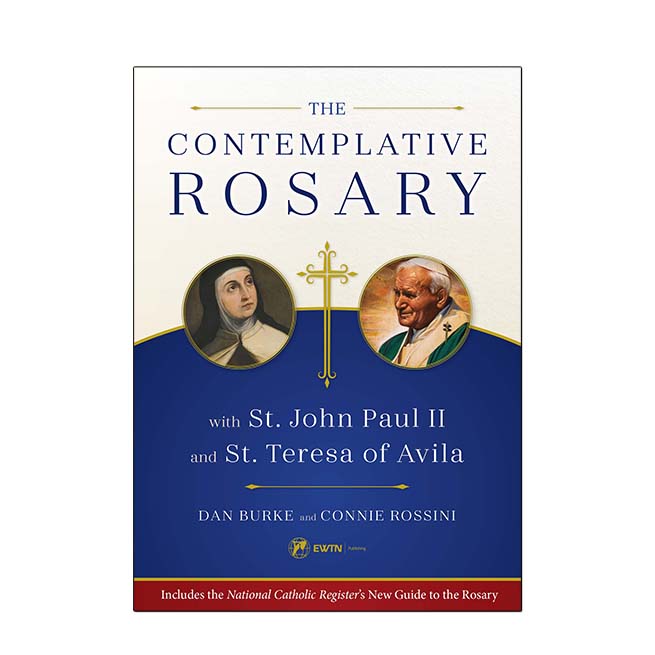Carmelite Contemplation of a Marian Devotion
BOOK PICK: The Contemplative Rosary

THE CONTEMPLATIVE ROSARY
With St. John Paul II and
St. Teresa of Avila
By Dan Burke and Connie Rossini
EWTN Publishing Inc., 2017
137 pages, $14.95
To order: ewtnrc.com or (800) 854-6316
People may grow uneasy when they hear the word “contemplation.”
Some may think of contemplation this way: “Maybe this is only for saints, and I’m not a saint.”
Still others might wonder if it’s going to take lots of time.
That’s where The Contemplative Rosary comes in, dispelling those notions, all in simple language that anyone can understand.
Dan Burke and Connie Rossini have made contemplation not only understandable, but downright desirable, helping readers learn how to pray from the heart. Readers are sure to end up saying, “Why hasn’t someone explained contemplation like this before?”
In each short chapter, from the first half of the book that lays the simple groundwork for contemplation to the second half, with reflections on each of the 20 Mysteries of the Rosary, the authors offer a guide to God’s Precious Son and Mother Mary through a contemplative Rosary.
The book is a natural outgrowth of the many requests the Register has received for its past Guide to the Rosary. Burke was inspired to renew and include it in the book as the National Catholic Register’s New Guide to the Rosary.

Throughout the book, Burke and Rossini — as they explain both vocal and contemplative prayer and how to approach them — call upon Sts. Teresa of Avila and John Paul II, two saints with different approaches to contemplative prayer, as experts.
The ideas from these mystics are clear-cut and uncomplicated, dispelling the idea that contemplative prayer is like untying a bunch of knots or finishing an impossible puzzle. For instance, the authors reassure readers “according to St. Teresa, who tells us the Our Father puts the petitions of the contemplatives in our mouths. This is a prayer Jesus gave to all Christians, even the youngest and least educated. If the petition implies infused graces, we can say that the prayer itself implies that all Christians are called to contemplative union with Christ.”
When it comes to the Holy Father, readers learn: “In Rosarium Virginis Mariae [The Most Holy Rosary] St. John Paul II writes that the contemplative face of Christ is ‘the task of every follower of Christ.’”
The book assures readers this should be our happy task and then shows how to do so: “In the Contemplative Rosary, we do this as we gaze upon Him through the holy eyes of the Mother of God.”
Again, there is reassurance that everyone can adapt to this method of praying.
“The Rosary provides us with an easy way to keep Jesus at our side as we pray. It was designed for this very purpose, to help ordinary Catholics to meditate on the life of Christ, drawing their hearts to worship Him.”
One of the book’s hallmarks is the way it encourages.
The authors put people’s minds to rest about distractions like daydreaming, noting that even St. Teresa had to struggle for years with interior distractions. She knew sickness, tending to a child and other situations prevented one from focusing fully on contemplation.
There’s no shortage of practical direction in this book.
Advice becomes visible as each of the 20 mysteries begins with a reproduction of a scene capturing or interpreting that mystery.
Several are from masters like Murillo, such as the Adoration of the Shepherds, Marriage Feast at Cana, and Resurrection.
This fits into lessons from John Paul II and Teresa of Avila. He encouraged using icons or other representations of each mystery to aid prayer, and she suggested using one’s senses or imagination to aid with focus.
The meditations and methods also assist one’s focusing of the intellect and will on Jesus.
John Paul II suggested reading a passage of sacred Scripture after each mystery is announced. Here, each mystery begins with the scriptural passage on which it’s based. The Hail Mary written out for each mystery incorporates Blessed Paul VI’s recommendation of adding an appropriate phrase after “Jesus,” which John Paul II also encouraged.
Each mystery ends with “Reflections” — suggestions to think about derived from the Catechism, Catholic writings or the authors themselves. Take this example from the Annunciation: “God lowered himself to become an embryo. Thus, we raise ourselves above God when we refuse service that is ‘beneath us.’”
Or for the Nativity: “We can count on God’s answers to our prayers, but often in unexpected ways — a stable instead of a room.”
For the Wedding Feast at Cana, this is offered: “Jesus chooses this for His first miracle to demonstrate clearly His regard for Mary’s petitions and for marriage. If we bring our needs to Mary, she will take care of them with and through her Son.”
The Institution of the Eucharist question asks: “How can I better prepare myself for receiving this great gift at Mass?”
“If Mary is our queen, she is queen of all aspects of our lives; not just our religious lives, but our social lives, work lives, home lives, and interior lives as well,” the reflection for the Coronation of Mary states.
In all respects, this practical guide is a solid companion to help one pray fully with the heart and come closer to Jesus and Mary, who will bring us closer to Christ.
is a Register staff writer.
- Keywords:
- book picks
- dan burke
- joseph pronechen
- rosary
- st. john paul ii
- st. teresa of avila
- the contemplative rosary

















